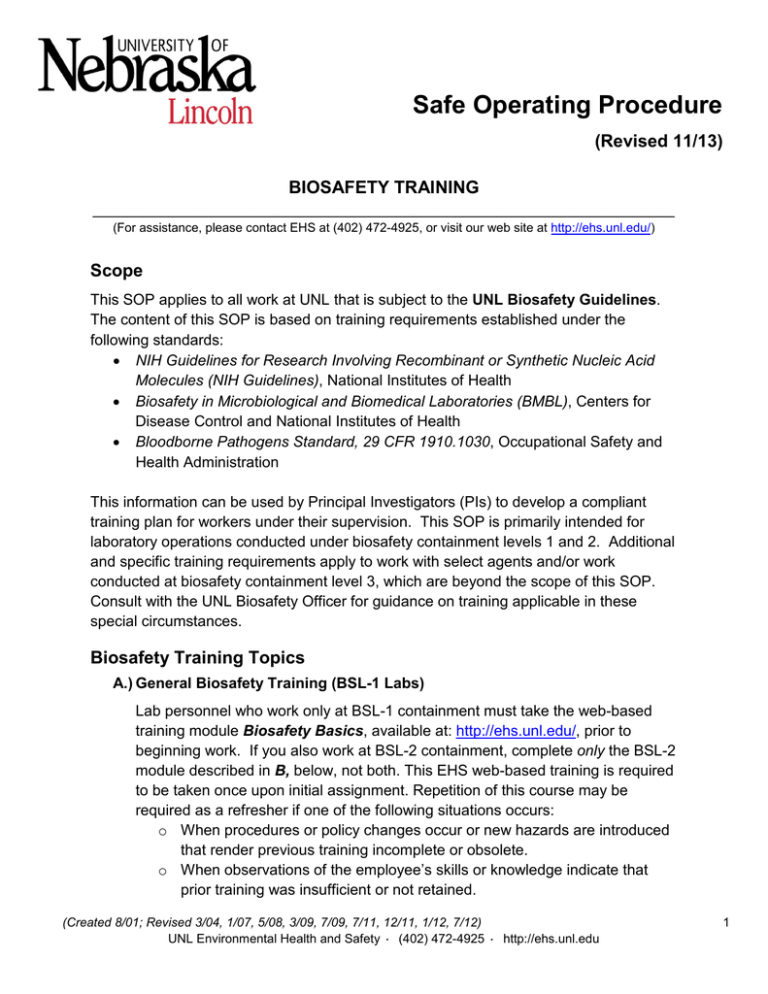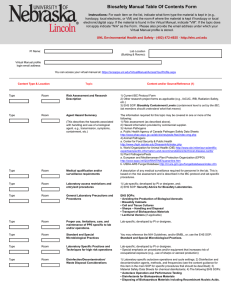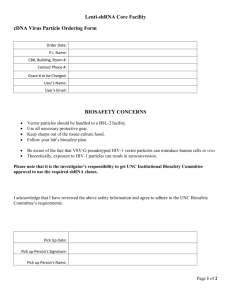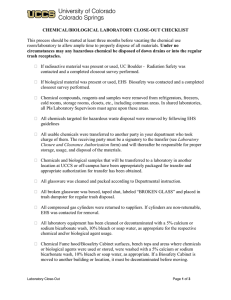Safe Operating Procedure (Revised 11/13) BIOSAFETY TRAINING
advertisement

Safe Operating Procedure (Revised 11/13) BIOSAFETY TRAINING _____________________________________________________________________ (For assistance, please contact EHS at (402) 472-4925, or visit our web site at http://ehs.unl.edu/) Scope This SOP applies to all work at UNL that is subject to the UNL Biosafety Guidelines. The content of this SOP is based on training requirements established under the following standards: • NIH Guidelines for Research Involving Recombinant or Synthetic Nucleic Acid Molecules (NIH Guidelines), National Institutes of Health • Biosafety in Microbiological and Biomedical Laboratories (BMBL), Centers for Disease Control and National Institutes of Health • Bloodborne Pathogens Standard, 29 CFR 1910.1030, Occupational Safety and Health Administration This information can be used by Principal Investigators (PIs) to develop a compliant training plan for workers under their supervision. This SOP is primarily intended for laboratory operations conducted under biosafety containment levels 1 and 2. Additional and specific training requirements apply to work with select agents and/or work conducted at biosafety containment level 3, which are beyond the scope of this SOP. Consult with the UNL Biosafety Officer for guidance on training applicable in these special circumstances. Biosafety Training Topics A.) General Biosafety Training (BSL-1 Labs) Lab personnel who work only at BSL-1 containment must take the web-based training module Biosafety Basics, available at: http://ehs.unl.edu/, prior to beginning work. If you also work at BSL-2 containment, complete only the BSL-2 module described in B, below, not both. This EHS web-based training is required to be taken once upon initial assignment. Repetition of this course may be required as a refresher if one of the following situations occurs: o When procedures or policy changes occur or new hazards are introduced that render previous training incomplete or obsolete. o When observations of the employee’s skills or knowledge indicate that prior training was insufficient or not retained. (Created 8/01; Revised 3/04, 1/07, 5/08, 3/09, 7/09, 7/11, 12/11, 1/12, 7/12) UNL Environmental Health and Safety · (402) 472-4925 · http://ehs.unl.edu 1 o When deemed necessary by the IBC or Biosafety Officer. B.) Biosafety Training for BSL-2 Labs All personnel working in labs operating at BSL-2 containment must take the webbased training module Biosafety in the BSL-2 Laboratory, available at: http://ehs.unl.edu/, prior to beginning work in the lab. This training should be supplemented with lab-specific instruction by the PI or designee (as described in E, below). If working at BSL-2 containment, complete only the BSL-2 module. It is not necessary to also take the Biosafety Basics course listed in A, above. This EHS web-based training is required to be taken once upon initial assignment. Repetition of this course may be required as a refresher if one of the following situations occurs: o When procedures or policy changes occur or new hazards are introduced that render previous training incomplete or obsolete. o When observations of the employee’s skills or knowledge indicate that prior training was insufficient or not retained. o When deemed necessary by the IBC or Biosafety Officer. C.) NIH Guidelines and Training for work with Recombinant or Synthetic Nucleic Acid Molecules When recombinant or synthetic nucleic acids (r/sNA) are used in the lab, all workers must be aware of the requirements of the NIH Guidelines and their responsibilities under the NIH Guidelines. All lab workers and PIs must complete the web-based training module NIH Guidelines for Research Involving Recombinant or Synthetic Nucleic Acid Molecules, available at: ehs.unl.edu, prior to beginning work with r/sNA. This is a one-time training requirement. Annual refresher training is not required. However, refresher training may be required in the following situations: o When procedures or policy changes occur or new hazards are introduced that render previous training incomplete or obsolete. o When observations of the employee’s skills or knowledge indicate that prior training was insufficient or not retained. o When deemed necessary by the IBC or Biosafety Officer. NIH Guidelines training is required in addition to the training described above for BSL-1 and BSL-2 laboratories. The EHS SOP, Recombinant or Synthetic Nucleic Acids - IBC and Other Review Requirements, provides a reference table for common types of research covered by the NIH Guidelines. (Created 8/01; Revised 3/04, 1/07, 5/08, 3/09, 7/09, 7/11, 12/11, 1/12, 7/12) UNL Environmental Health and Safety · (402) 472-4925 · http://ehs.unl.edu 2 D.) Bloodborne Pathogens Training (Required Annually) Lab workers who work with or are exposed to human materials including human cell lines, tissues, organs, and certain body fluids (blood, semen, vaginal fluid, cerebrospinal fluid, etc.) or certain bloodborne pathogens (HIV and Hepatitis B) are required to enroll in the UNL Bloodborne Pathogens (BBP) program and take OSHA Bloodborne Pathogens training. This training is available at: http://ehs.unl.edu/. OSHA’s Bloodborne Pathogen Standard requires annual re-training. Therefore, all staff enrolled in the UNL BBP program must complete the EHS web-based Bloodborne Pathogens training module each year. Refer to the UNL Exposure Control Plan (http://ehs.unl.edu/documents/bloodbornepathogens) for more details about this program. E.) Lab-specific Training (All Labs) The laboratory-specific biosafety manual forms the basis for lab-specific training (See EHS SOP, Preparing a Laboratory Biosafety Manual). Reading the manual is imperative. But, hands-on demonstration of proficiency is also important. The PI is responsible to ensure that all laboratory workers receive adequate training. Lab-specific training must be conducted at the following frequency: o Upon initial assignment o At least annually thereafter o And in response to one of the following: When procedures or policy changes occur or new hazards are introduced that render previous training incomplete or obsolete. When observations of the employee’s skills or knowledge indicate that prior training was insufficient or not retained. When deemed necessary by the IBC or Biosafety Officer. Following is a list of topics to include in lab-specific training. 1. Potential hazards posed by the agent in use, as well as personal health conditions that may impact an individual’s susceptibility to infection. This information is generally captured in the risk assessment conducted in support of the protocol, which is reviewed by the Institutional Biosafety Committee (IBC). A copy of the approved protocol must be included in the laboratory-specific biosafety manual. Agent hazard information for some human pathogens can be found at the following web site: Public Health (Created 8/01; Revised 3/04, 1/07, 5/08, 3/09, 7/09, 7/11, 12/11, 1/12, 7/12) UNL Environmental Health and Safety · (402) 472-4925 · http://ehs.unl.edu 3 Agency of Canada - http://www.phac-aspc.gc.ca/lab-bio/res/psdsftss/index-eng.php. 2. Instruction on the specific medical qualification, testing, or surveillance that is required as a condition of the IBC’s approval of the protocol, and the basis/reasoning for such requirements. This information is generally captured in the protocol that is reviewed by the IBC. 3. Instruction/guidance relative to laboratory access restrictions, as well as specific entry, exit, and security policies and procedures. This information is generally captured in the protocol that is reviewed by the IBC and documented on the laboratory door placard. The EHS SOP, Door Postings for Potentially Hazardous Locations, provides explanatory information. 4. PIs must provide laboratory workers with access to written, relevant, and laboratory-specific procedures by including these in the laboratory-specific biosafety manual. In the case of inexperienced workers, a progression of work activities must be assigned as techniques are learned and proficiency is demonstrated with standard and special microbial practices, aseptic technique, and lab-specific procedures and protocols. 5. Decontamination and Disposal methods used in the laboratory. Refer to the EHS SOP, Disposing of Biohazardous Materials Including Recombinant Nucleic Acids, for guidance on this topic. This training should also include instruction in proper operation of the autoclave (if applicable). See the EHS SOP, Autoclave Operation and Performance Testing. 6. Assigned Personal Protective Equipment (PPE), based on task to include proper use, care, and maintenance, and limitations. 7. Proper use of containment equipment, including biosafety cabinets. Refer to the EHS SOP, Biosafety Cabinets. 8. Emergency procedures and spill protocols, including location, content, and limitations of spill materials. (Created 8/01; Revised 3/04, 1/07, 5/08, 3/09, 7/09, 7/11, 12/11, 1/12, 7/12) UNL Environmental Health and Safety · (402) 472-4925 · http://ehs.unl.edu 4 Additional Considerations Additional information on many of these items can be found on the EHS website at http://ehs.unl.edu 1. Use of a respirator requires full participation in UNL’s Respiratory Protection Program, which includes medical qualification, annual training, and fit-testing. Training is accomplished via EHS. 2. All laboratory workers should complete EHS Core Training, which includes the following modules: UNL’s Injury and Illness Prevention Plan, Emergency Preparedness, and Chemical Safety training; Additional online training modules that may be applicable include: Personal Protective Equipment, Fire Extinguisher Training and General Electrical Safety Awareness. In addition, this general training should be supplemented with instruction on building specific alarms, evacuation routes, shelter-in-place locations, locations of alarm stations, etc. See UNL’s Emergency Planning and Preparedness website at http://emergency.unl.edu/. 3. PIs are encouraged to create a general laboratory safety manual, as a supplement to the biosafety manual. EHS SOPs and the Virtual Manual tool can be used for this purpose. The Virtual Manual will also identify other relevant safety-related training that may be appropriate. Documented review of the virtual manual and lab-specific documents (e.g., IBC protocol and Agent-hazard information) satisfies the annual refresher requirement. 4. Use of radioactive materials and/or radiation-producing devices is subject to prior approval by the Radiation Safety Committee and requires specific training, delivered solely by EHS. 5. Use of vertebrate animals is subject to prior approval by the Institutional Animal Care and Use Committee (IACUC) and requires specific training. http://research.unl.edu/orr/animalsubjectsresearch.shtml 6. Any person who participates in a transport function related to hazardous materials/dangerous goods (e.g., signs paperwork, conducts packaging, etc.) must participate in the EHS DOT/IATA training program. Many body fluids, human and animal diagnostic specimens, cultures, and even small quantities of chemicals or preservatives are considered dangerous goods. Training Records The OSHA Bloodborne Pathogen Standard (29 CFR 1910.1030) mandates that training records be maintained for a minimum of three years from the date that training occurred. EHS maintains these records since training is accomplished via an EHS (Created 8/01; Revised 3/04, 1/07, 5/08, 3/09, 7/09, 7/11, 12/11, 1/12, 7/12) UNL Environmental Health and Safety · (402) 472-4925 · http://ehs.unl.edu 5 maintained web-based module. EHS will also maintain records of persons taking any other EHS web-based module (e.g., Biosafety Basics, BSL-2, NIH Guidelines, etc.). PIs are responsible to maintain records of training that is provided under their supervision, including lab-specific annual refresher training (review of topics covered by the lab-specific biosafety manual by all laboratory workers). While the NIH Guidelines and BMBL are silent as to maintenance of training records, PIs are encouraged to maintain training records for three (3) years. Model training documentation forms (limited in scope to biosafety training) are included in Appendices A and B to this SOP. These forms are provided for convenience only. Equivalent documentation is acceptable. (Created 8/01; Revised 3/04, 1/07, 5/08, 3/09, 7/09, 7/11, 12/11, 1/12, 7/12) UNL Environmental Health and Safety · (402) 472-4925 · http://ehs.unl.edu 6 Appendix A Record of Biosafety Training for Authorized Laboratory Personnel *Recommended training modules Personnel must print and sign their name as indicated below (Created 8/01; Revised 3/04, 1/07, 5/08, 3/09, 7/09, 7/11, 12/11, 1/12, 7/12) 1 UNL Environmental Health and Safety · (402) 472-4925 · http://ehs.unl.edu Emergency Procedures and Spill Protocols Medical Surveillance Provisions Lab Security Provisions Proper use of containment equipment & BSC PPE use, limitation, care, and maintenance Demonstrated proficiency with Standard and Special Microbial Practices; LabSpecific Procedures; and Aseptic Technique Disinfection and Decontamination Read Biosafety Manual Bloodborne Pathogens (If applicable) NIH Guidelines (if applicable) Biosafety Training (Biosafety Basics or BSL-2) PPE Training* Chemical Safety (Cross out names of individuals no longer working in the lab) Injury/Illness & Emergency Prep. Printed Name Signature Record Date Completed (MM/DD/YY) (Record NA if Not-Applicable) EHS Online Training Lab-Specific Training Appendix B Lab-Specific Biosafety Refresher Training Use additional pages as necessary. Review of entire Lab-Specific Biosafety Manual or; Topics Covered (check all that apply) Bloodborne Pathogens Proper use of containment equipment & BSC Standard and Special Microbial Practices Lab Security Provisions Lab-Specific Special Procedures Medical Surveillance Provisions Agent hazard information Emergency Procedures and Spill Protocols Disinfection and Decontamination PPE use, limitation, care, and maintenance Printed Name Other: Signature Date Completed (MM/DD/YY) 1 2 3 4 5 6 7 8 9 10 11 12 13 14 15 Trainer Printed Name Signature (Created 8/01; Revised 3/04, 1/07, 5/08, 3/09, 7/09, 7/11, 12/11, 1/12, 7/12) UNL Environmental Health and Safety · (402) 472-4925 · http://ehs.unl.edu 1




